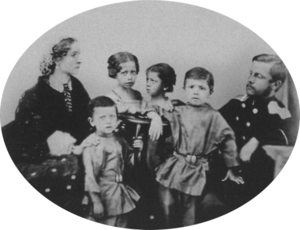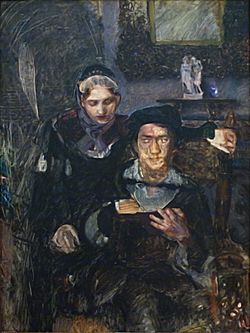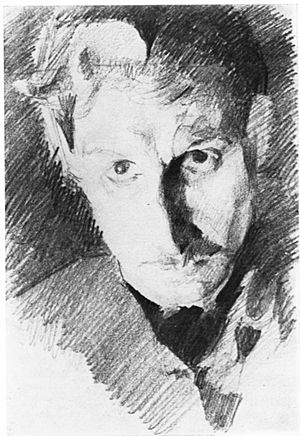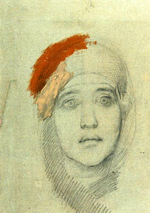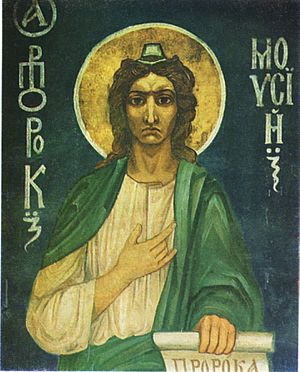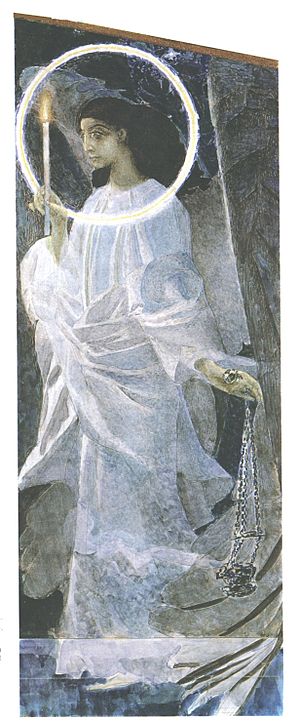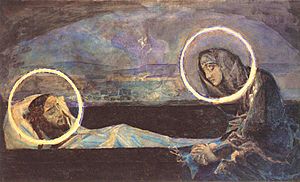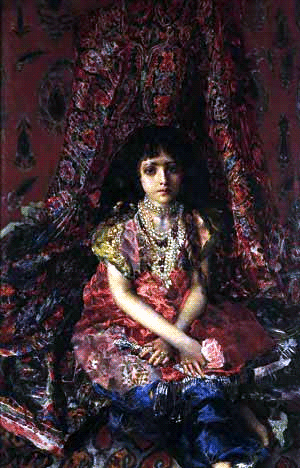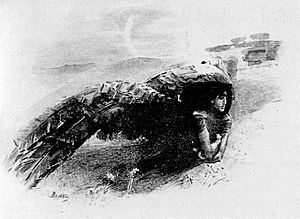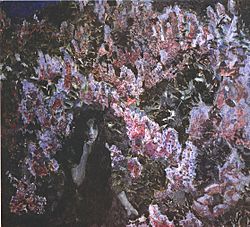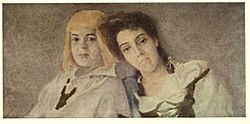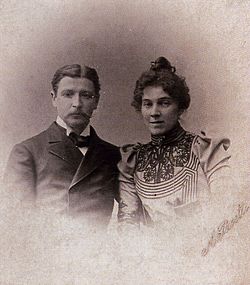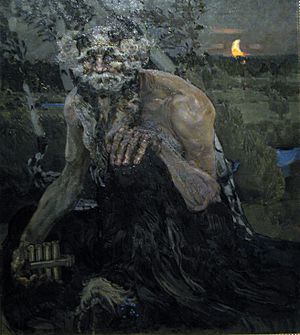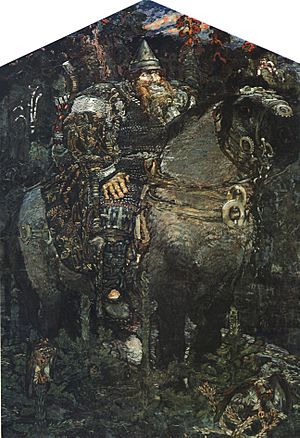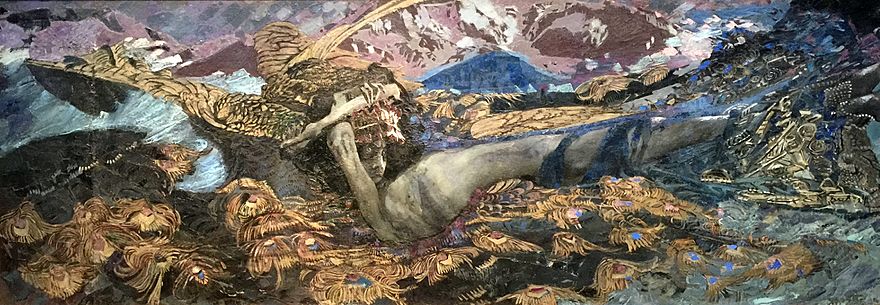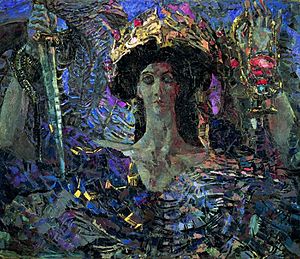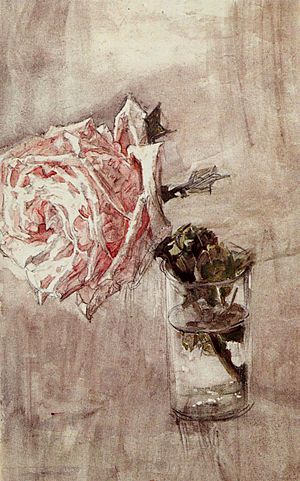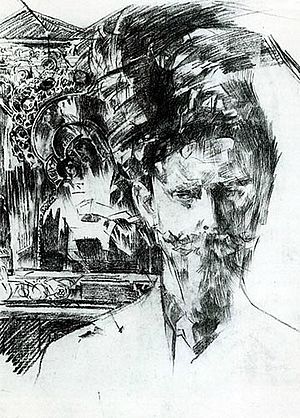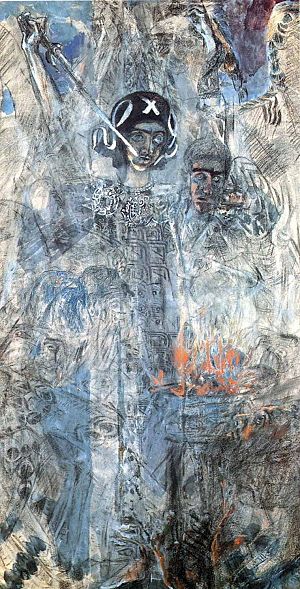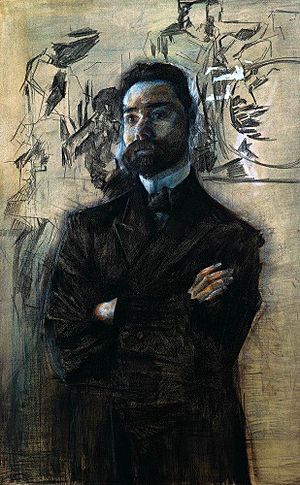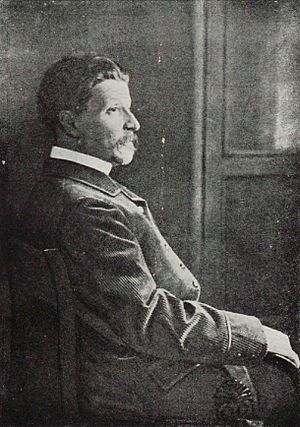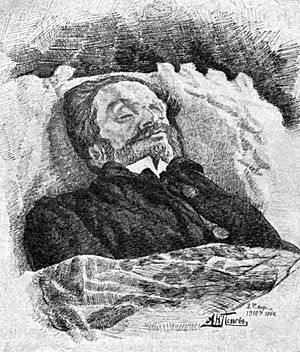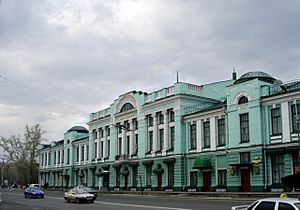Mikhail Vrubel facts for kids
Quick facts for kids
Mikhail Vrubel
|
|
|---|---|

At work, 1900s
|
|
| Born |
Mikhail Aleksandrovich Vrubel
March 17, 1856 |
| Died | April 14, 1910 (age 54) Saint Petersburg, Russian Empire
|
| Nationality | Russian |
| Education | Member Academy of Arts (1905) |
| Alma mater | Imperial Academy of Arts |
| Known for | Painting, drawing, decorative sculpture |
|
Notable work
|
The Demon Seated (1890) The Swan Princess (1900) |
| Movement | Symbolism |
| Patron(s) | Savva Mamontov |
Mikhail Aleksandrovich Vrubel (Russian: Михаил Александрович Врубель; March 17, 1856 – April 14, 1910) was a famous Russian painter, draughtsman, and sculptor. He was a very creative artist who worked in many different art forms. Vrubel is known as one of the most important artists in the Russian Symbolist movement. He was also a key figure in early Modernist art.
A historian named Nina Dmitrieva described Vrubel's life and art as a play with three acts. The first part was his early years of studying art. The "first act" was in the 1880s when he studied at the Imperial Academy of Arts. Then he moved to Kiev to learn about Byzantine and Christian art. The "second act" was his "Moscow period," which began with his painting The Demon Seated in 1890. This period ended in 1902 with The Demon Downcast. The "third act" lasted from 1903 to 1906. During this time, Vrubel faced health challenges that affected his ability to paint. For the last four years of his life, he was unable to see.
In the 1880s and 1890s, Vrubel's art was not always supported by art critics. However, many private art collectors loved his paintings. One famous art supporter was Savva Mamontov. Other painters and critics who worked with the journal Mir iskusstva also admired his work. Vrubel's art was shown in their exhibitions. By the early 1900s, Vrubel's art became a big part of Art Nouveau in Russia. In 1905, he was given the title of Academician of Painting for his artistic achievements. This happened near the end of his painting career.
Contents
Becoming a Painter
Early Life and Family
Mikhail Vrubel's family was not from the nobility. His great-grandfather was a judge from Białystok. Mikhail's grandfather, Mikhail Antonovich Vrubel, was a military officer. He had seven children. His son Alexander, Mikhail's father, also served in the military. In 1855, Alexander and his first wife, Anna Basargina, had their first child, Anna Aleksandrovna. They had four children in total.
Mikhail Vrubel was born on March 17, 1856, in Omsk. His father was working there at the time. Two of Mikhail's siblings, Alexander and Ekaterina, also born in Omsk, passed away when they were young. Mikhail's mother became very ill and died in 1859 when Mikhail was only three years old. He remembered his sick mother cutting out paper figures for her children. Mikhail was a weak child and did not walk until he was three.
Because his father moved often for work, Mikhail and his sister Anna lived in many different places. In 1859, they moved to Astrakhan, where relatives could help with the children. In 1861, the family moved to Kharkov. There, young Mikhail quickly learned to read. He loved looking at the pictures in books and in the journal Zhivopisnoe obozrenie.
In 1863, Mikhail's father married Elizaveta Vessel. She was from Saint Petersburg and took good care of her husband's children. In 1867, the family moved to Saratov. Elizaveta's family was well-educated. Her sister, Alexandra Vessel, was a musician and introduced Mikhail to music. Elizaveta also helped Mikhail improve his health. Her brother, Nicolai Vessel, was a teacher and helped with the children's education through games. By age 10, Mikhail showed talent in drawing, theater, and music. He enjoyed these activities as much as painting.
Mikhail's father hired a private art teacher, Andrei Godin, from the Saratov gymnasium. Around this time, a copy of "The Last Judgment" by Michelangelo was shown in Saratov. Mikhail was so impressed that he drew it from memory, including all the details.
School Years
Mikhail Vrubel started school at the Fifth St. Petersburg Gymnasium. This school focused on modern teaching methods and classical studies. Mikhail's father also lived in Saint Petersburg and attended lectures. Besides school, Mikhail took painting classes. But he was most interested in science, thanks to his teacher Nicolai Peskov. In 1870, after three years in Saint Petersburg, the Vrubel family moved to Odessa. His father was appointed a judge there.
In Odessa, Mikhail studied at the Richelieu Lyceum. He wrote letters to his sister Anna, who was studying in Saint Petersburg. In these letters, he mentioned paintings he made, like portraits of his younger brother and Anna. However, painting was not his main focus then. Vrubel was a fast learner and was top of his class. He loved literature, languages, and history. He even read Goethe's Faust in its original language. He once complained that instead of reading or doing English exercises, he copied a painting by Ivan Aivazovsky. At this time, he was more interested in theater than painting.
University Studies
After finishing school with honors, Vrubel and his parents did not plan for him to be an artist. He went to Saint Petersburg State University to study law. He lived with his uncle Nicolai Vessel, who helped with his expenses. Some people thought he chose law because it was a family tradition. In 1876, Vrubel had to repeat his second year because of low grades. He studied for an extra year but did not finish his final paper. He graduated with the lowest academic degree.
Vrubel loved philosophy, especially the ideas of Immanuel Kant. He also enjoyed a free-spirited lifestyle that his uncle allowed. He did not paint much during this time, but he did create some drawings for books. One famous drawing from this period is "The date of Anna Karenina with the son." This drawing looked like pictures found in journals of that time. Vrubel was also very involved in theater and knew the composer Modest Mussorgsky. To earn money, Vrubel worked as a tutor. In 1875, he traveled to Europe with one of his students, visiting France, Switzerland, and Germany.
Later, Vrubel met students from the Imperial Academy of Arts who worked with the painter Pavel Chistyakov. Vrubel started taking evening classes at the Academy to improve his drawing skills. At 24, after finishing university and a short military service, Vrubel was accepted into the Imperial Academy of Arts. This was a big turning point in his life.
The 1880s: Art Academy and Kiev
Studying at the Academy of Arts
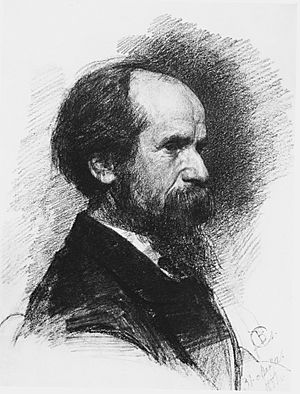
Vrubel's decision to study art was partly inspired by Kant's ideas about art and genius. He believed that a "genius" could work in a special way that combined freedom and nature, which could only happen in art. Vrubel saw himself as a genius.
From 1880, Vrubel attended classes at the Academy. He also took private lessons with Pavel Chistyakov, who he said was the best teacher. Vrubel later called his time at the Academy "the brightest in his artistic career." He wrote to his sister that Chistyakov's ideas about art felt natural to him.
Chistyakov taught many famous artists, including Ilya Repin and Valentin Serov. All of them respected Chistyakov. His teaching method was academic but also focused on each student's unique style. Chistyakov taught how to break down a painting into smaller parts to understand its shape and form. Vrubel's unique "crystal-like" painting style was developed from his teacher's methods.
One important friend Vrubel made at the Academy was Valentin Serov. They became very close. During his time with Chistyakov, Vrubel's style changed. He became more focused on his art. In 1881, he also took watercolor lessons with Repin. However, Vrubel and Repin had disagreements about art. Vrubel believed that true art should be unique and not just copied.
One of Vrubel's early works from the Academy is "Feasting Romans." Even though it followed some rules of academic art, it broke others. The painting did not have a clear main focus, and the story was hard to understand. Vrubel worked on this painting for almost two years. He wanted it to look like paintings by Lawrence Alma-Tadema. The final sketch was praised by Repin, but Vrubel left the painting unfinished.
Vrubel wanted to earn money from his art. He got a job from a rich industrialist, Leopold Koenig, to paint something of his own choice for 200 rubles. Mikhail also entered a contest with a painting called "Hamlet and Ophelia," inspired by Rafael's realism. He made self-portraits for Hamlet. But he struggled with this painting. His friends convinced him to paint a real-life model instead. He painted "Sitter in the Renaissance Setting," which showed his unique "painting embossing" style. After this success, he returned to "Hamlet," using Serov as his model.
Vrubel did not officially graduate from the Academy. However, in 1883, his painting "Betrothal of Mary and Joseph" won a silver medal. Later that year, Professor Adrian Prakhov invited Vrubel to Kiev. He wanted Vrubel to help restore the 12th-century St. Cyril's Monastery. This was a great opportunity and promised good pay, so Vrubel agreed.
Time in Kiev
The years Vrubel spent in Kiev were very important for his art. He was able to work on large-scale projects and connect with the roots of Russian art. In five years, he created many paintings. He painted murals and icons for the St. Cyril's church. He also made 150 drawings for the restoration of an angel figure in the dome of the St. Sophia Cathedral. He worked with ancient masters' styles, bringing old art into modern times.
Prakhov invited Vrubel because he needed a skilled painter who would not ask for too much money. Vrubel's contract was to paint four icons in 76 days for 300 rubles.
Vrubel made a striking entrance in Kiev. A student who met him described him as looking like a young Venetian from a Tintoretto or Titian painting, wearing a black velvet suit.
One of Vrubel's frescoes, "Descent of Holy Spirit on the Apostles," in St. Cyril's church, combined Byzantine art with his own style. It showed twelve Apostles in a circle, with Mary in the center. The background was blue, and golden rays shone on the apostles. Vrubel painted this directly on the wall without many sketches. This style was inspired by Byzantine art.
First Trip to Italy
Vrubel traveled to Venice with a young artist named Samuel Gaiduk. They shared a studio in the city center. Vrubel was interested in the churches on the island of Torcello.
In Venice, Vrubel was not drawn to the famous artists like Titian. Instead, he focused on medieval mosaics and stained glass. He also studied early Renaissance painters like Vittore Carpaccio and Giovanni Bellini. His time in Kiev helped him with shapes, and Venice helped him with colors.
Vrubel painted three icons for St. Cyril's Church in Venice: "Saint Kirill," "Saint Afanasii," and "Christ the Savior." He finished all four icons in a month and a half. He even met the famous scientist Dmitri Mendeleev there. They discussed how to preserve paintings in humid conditions. Vrubel used zinc boards for his icons, but it was hard to make the paint stick. In April, he wanted to return to Russia.
Back in Kiev and Odessa
After returning from Venice in 1885, Vrubel spent time in Kiev. There were rumors that he proposed to Emily Prakhova, who was already married. Even though he was still allowed in her house, her husband was wary of him. An artist friend later recalled Vrubel showing him scars on his chest, saying he cut himself because a woman he loved did not understand him.
In June 1885, Vrubel went to Odessa. He reconnected with sculptor Boris Edwards, who tried to convince Vrubel to stay in Odessa. That summer, Serov visited Odessa, and Vrubel first told him about his plan to paint the "Demon." Vrubel also mentioned working on a series of four paintings. In 1886, he went to Kiev for the New Year.
In Kiev, Vrubel met writer Ieronim Yasinsky's friends and Konstantin Korovin. Despite working hard, Vrubel lived a free-spirited life and spent a lot of time at a café. This used up his money. He started getting money from a sugar manufacturer, Ivan Tereshchenko, for a painting called "Oriental Tale."
Adrian Prakhov organized the painting of the St Volodymyr's Cathedral and invited Vrubel. Vrubel created six versions of "Tombstone Crying." This scene is not common in Russian Orthodox art but is seen in Italian Renaissance icons. Prakhov did not use Vrubel's independent paintings because they looked too different from the other artists' works. Prakhov said a new cathedral would be needed for Vrubel's paintings.
Vrubel also tried to paint "Praying for the cup" for himself. But he had a difficult time finishing it. He wrote to his sister that religious rituals felt strange to him.
While painting church murals, Vrubel was also drawn to the image of the Demon. His father visited him in Kiev and was worried about Mikhail's lifestyle and his first version of the "Demon." His father thought the public would not like it. Mikhail destroyed that painting and many other works from Kiev. To earn money, he tried to finish the "Oriental Tale" watercolor. He offered it to Emily Prakhova as a gift, but she rejected it, so he tore it up. Then he glued the pieces back together. The only finished painting from this time was "Portrait of a Girl against a Persian Carpet." The customer did not like it, but Tereshchenko later bought it.
Vrubel's emotional state was difficult. Once, he told artists that his father died and he needed to go to Kharkov. They gave him money for the trip. The next day, his father came looking for him, and Prakhov realized Vrubel had made up the story because he was interested in a singer. Friends tried to help Vrubel get regular income. He got small jobs at the Vladimyr's Cathedral and started teaching at the Kiev Art School. These jobs were not official.
The Moscow Period (1890–1902)
Moving to Moscow
In 1889, Mikhail Vrubel traveled to Kazan because his father was very ill. His father recovered but had to retire and settled in Kiev. In September, Mikhail visited Moscow and decided to stay for the next 15 years.
Vrubel's move to Moscow was unplanned. He might have gone because he was interested in a circus performer. He stayed at Konstantin Korovin's studio. Korovin later introduced Vrubel to the famous art patron Savva Mamontov. In December, Vrubel moved into Mamontov's house. However, Mamontov's wife did not like Vrubel and called him "a blasphemer and a drunkard." Soon, Vrubel moved to a rented apartment.
The Demon Paintings
Vrubel returned to the theme of the Demon when he was asked to illustrate a two-volume book for the anniversary of Mikhail Lermontov. Eighteen painters worked on the book, but Vrubel was unknown to the public. He was paid a small amount for his illustrations. His paintings were hard to print, and he had to change them. Other artists did not understand his work. When the book was published in 1891, critics strongly disliked his illustrations, calling them "ugly" and "absurd." Vrubel then believed that "true art" was hard for most people to understand.
Vrubel made his illustrations in black watercolor. This helped show the dramatic nature of the story. The Demon was shown as a "fallen angel" with both male and female features. Tamara was depicted differently in each image, showing her difficult choice. Vrubel's illustrations showed his great skill as a graphic artist.
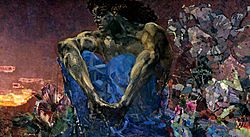
While working on the illustrations, Vrubel painted his first large work on the same theme, "The Demon Seated." This painting shows the Demon at the beginning of Lermontov's poem, feeling empty and sad. It is one of Vrubel's most famous Demon paintings and is less tied to the story.
The painting used many colors but still felt simple. Vrubel used blues and purples, like Byzantine mosaics. His paintings often had a glowing, sparkling effect, which gave them a spiritual, otherworldly feeling. The flowers around the Demon look like cold crystals, showing the lifelessness of his surroundings. The Demon's strong, muscular body and clasped hands contrast with his sad face and slumped posture. He is not shown as evil, but as a suffering human. This painting shows Vrubel's search for spiritual freedom. The Demon does not have wings, but their shape is suggested by the flowers and hair behind him. Vrubel returned to this image eight years later.
Abramtsevo Studios
On July 20, 1890, Vrubel's friend A. Mamontov passed away. Vrubel attended the funeral in Abramtsevo Colony. He loved the area so much that he decided to stay. In Abramtsevo, Vrubel became very interested in ceramics. He soon became the head of a "factory of ceramic tiles and terracotta decorations." Savva Mamontov supported Vrubel's talent and helped him. For the first time, Vrubel earned good money from his art. He made ceramic pieces, decorated a chapel, and designed an extension for Mamontov's house.
Vrubel was very versatile. He worked with sculpture, mosaics, stained glass, maiolica, and theatrical designs. He created many decorative ideas, like sirins, rusalkas, and knights. He wanted to create "pure and stylishly beautiful" art that could be part of everyday life. Vrubel became one of the founders of the "Russian Art Nouveau" style.
Mamontov's studio in Abramtsevo and Tenisheva's studio in Talashkino were inspired by the "Arts and Crafts movement." They wanted to bring back traditional Russian crafts. Vrubel worked at both studios. The Abramtsevo Potter's Factory helped bring back maiolica art in Russia. Vrubel liked maiolica because it was simple and allowed him to experiment with shapes and colors. He could freely create his artistic ideas. The ceramist Peter Vaulin helped Vrubel bring his designs to life.
Second Trip to Italy
In 1891, the Mamontov family traveled to Italy. Vrubel went with them as an art consultant. This caused some conflict with Mamontov's wife. So, Mamontov and Vrubel went to Milan, where Vrubel's sister Elizaveta was studying. Vrubel was supposed to spend the winter in Rome to finish designs for a play and a new theater curtain. Mamontov paid Vrubel a monthly salary. Vrubel ended up staying with the Svedomsky brothers.
Vrubel did not get along with other Russian artists in Rome. He was closer to Alexander and Pavel Svedomsky. They recognized Vrubel's talent and shared their art jobs with him. Mamontov later arranged for Vrubel to stay at the studio of Alexander Rizzoni, who Vrubel respected. Rizzoni encouraged Vrubel to be diligent in his work.
In winter 1892, Vrubel planned to show his work at the Paris Salon. He got an idea for a painting called "Snow-maiden" (which is now lost). Elizaveta Mamontova joked that he had to come to Rome to paint Russian winter.
Vrubel continued to work in Abramtsevo. After returning from Italy, he painted landscapes from photographs. One important work was the panel "Venice," also based on a photograph. It showed a timeless scene. He also painted "Spain," which critics considered one of his best works.
Decorative Artworks
Vrubel spent the winter of 1892–1893 in Abramtsevo. His reputation grew in Moscow because of his work for Mamontov. He was hired to decorate the Dunker family mansion. He also worked with the famous architect Fyodor Schechtel to decorate other mansions.
Vrubel's decorative works showed his wide range of talents. He combined painting with architecture, sculpture, and applied art. He played a key role in creating the look of Moscow Modern buildings. His sculptures also gained attention.
The sculpture "Robert and the Nuns" is considered one of Vrubel's most important sculptures. It decorates the staircase of the Morozov mansion. Vrubel created many small sculptures and tiles that decorated important buildings in modern and Russian styles, such as the Moscow Yaroslavsky railway station. Mamontov's mansion was built based on Vrubel's ideas. He also led projects for a church and an exhibition pavilion in Paris.
Until November 1893, Vrubel worked on "The Judgment of Paris" for the Dunker mansion. However, the customers did not like it, or his "Venice" painting. A collector named Konstantin Artsybushev later bought both works. Artsybushev also set up a studio in his house where Vrubel stayed. Vrubel's sister Anna moved to Moscow and saw him more often.
In 1894, Vrubel experienced a period of sadness. Mamontov sent him to Italy to look after his son Sergei, who was ill. Vrubel did not like gambling. In April, after returning to Odessa, Vrubel was again struggling financially. He returned to maiolica art, creating the "Demon's head." Artsybushev bought this work, and Vrubel used the money to return to Moscow.
Around the same time, Vrubel painted "The Fortune Teller" in one day. The painting shows a dark-haired woman sitting against a carpet, similar to his portrait of Mani Dakhnovich. Her face is unreadable, and she does not look at the cards. The pink scarf on her shoulders stands out. Vrubel was inspired by the opera Carmen for this painting. He painted it over a destroyed portrait of Mamontov's brother.
Vrubel continued his free-spirited lifestyle. After getting a large payment for some watercolor panels, he spent it all on a big dinner party at his hotel. He invited everyone there, including musicians and actors. He told his friend, "How happy I am. I feel like a rich man." He spent 5,000 rubles and had to work hard for two months to pay off the debt.
Nizhny Novgorod Exhibition, 1896
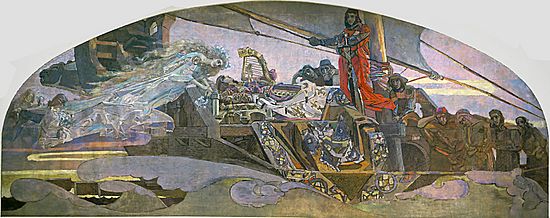
In 1895, Vrubel tried to gain recognition in Russian art circles. He sent a portrait to an exhibition, but it was rejected. He did show his sculpture "The Head of Giant" at another exhibition. A newspaper criticized this work, saying it lacked artistic beauty.
Later, Vrubel participated in the All-Russia Exhibition 1896, which was for the coronation of Nicholas II. Savva Mamontov was in charge of the Russian North section. He noticed two large empty walls in the art pavilion. Mamontov asked Vrubel to paint two huge panels, each 20 by 5 meters, in three months. Vrubel was busy but agreed. He planned to paint "Mikula Selyaninovich" for the first wall, showing the Russian land. For the second wall, he chose "The Princess of the Dream," inspired by a French poem, symbolizing his dream of beauty.
It was impossible to finish such large paintings so quickly. Vrubel had another painter, T. Safonov, start "Mikula" based on his sketches. A. Karelin finished the decorative border.
On March 5, 1896, a member of the Academy of Arts, Albert Nikolayevitch Benois, said that Vrubel's work did not fit the exhibition's theme. He demanded to see Vrubel's sketches. After seeing them, Benois sent a telegram saying Vrubel's panels were "terrifying" and should be removed.
On May 3, the Academy committee decided that Vrubel's works could not be shown. Mamontov told Vrubel to keep working and tried to convince the committee. Vrubel realized he had made a mistake with the figures in "Mikula" and started painting a new version right there at the pavilion. Mamontov's efforts failed, and on May 22, Vrubel's works were removed from the exhibition hall.
Vrubel did not lose money because Mamontov bought both paintings for 5,000 rubles each. Mamontov also arranged for other painters to finish "Mikula." Vrubel finished "The Princess of the Dream" at the Abramtsevo Pottery factory. Both paintings arrived in Nizhny Novgorod just before the emperor's visit. Later, a fountain at the Hotel Metropol Moscow was decorated with a maiolica panel of "The Princess of the Dream," made at Abramtsevo.
Vrubel traveled to Europe for personal matters, while Mamontov handled things in Moscow. Mamontov built a special pavilion called "Exhibition of decorative panels made by Vrubel and rejected by the Academy of Arts." This started big discussions in newspapers. Some writers, like Nikolai Garin-Mikhailovsky, wrote positively about Vrubel's art. However, Maxim Gorky criticized Vrubel, making fun of "Mikula" and calling "The Princess of the Dream" ugly. Gorky wrote five articles criticizing Vrubel's art.
Later, Konstantin Korovin shared a story about how officials reacted to the scandal. When Vrubel was ill, an exhibition opened where his painting "The Lilacs" was shown. The emperor liked it, but a Grand Duke called it "decadence." The emperor insisted he liked it and asked who the artist was. When told it was Vrubel, he asked if it was "the one who was executed in Nizhny?" This showed how much debate Vrubel's art caused.
Marriage and Later Work (1896–1902)
In early 1896, Vrubel went to Saint Petersburg to visit Savva Mamontov. Around this time, the opera "Hansel and Gretel" was having its Russian premiere. Mamontov was very involved in this production. Konstantin Korovin was supposed to design the costumes, but he got sick. So, Mikhail Vrubel, who had never been to an opera, took over. At a rehearsal, Vrubel saw Nadezhda Zabela-Vrubel, who played Gretel's sister.
Nadezhda Zabela later recalled that Vrubel ran up to her, kissed her arm, and said, "What an amazing voice!" They were introduced, and Vrubel proposed to Nadezhda soon after. Her parents were concerned about the age difference (he was 40, she was 28). Nadezhda knew that Vrubel was not good with money. Still, they got married on July 28 in Geneva, Switzerland. They spent their honeymoon in Lucerne. Vrubel was very poor at the time and had to walk to Nadezhda's house from the train station.
In the fall of 1896, Nadezhda Zabela Vrubel had a short contract with the Kharkov opera. Vrubel did not have many jobs there, so he lived on his wife's money. He started designing costumes for her. Vrubel's productive "Moscow period" was greatly helped by Nadezhda and her love for Nikolai Rimsky-Korsakov's music. They met Rimsky-Korsakov in 1898. Nadezhda said Vrubel listened to the opera "Sadko," in which she sang, at least 90 times. He told her he loved listening to the orchestra, especially the sea part, finding new wonders in it every time.
In January 1898, Ilya Repin advised Vrubel not to destroy his panel Morning, which a client had rejected. Repin suggested showing it at another exhibition. It was then displayed at an exhibition of Russian and Finnish painters.
In summer 1898, Vrubel started having strong headaches and anxiety. He became very upset if someone disagreed with his art opinions.
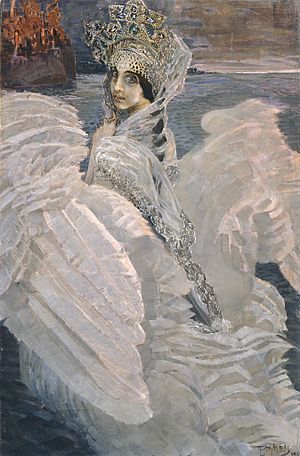
In the late 1800s, Vrubel painted scenes from fairy tales and myths, like Bogatyr, Pan, and Tsarevna-Lebed.
In his 1899 painting ‘Pan’, Vrubel shows the connection between humans and nature. The figure looks like a 'leshiy', a Russian forest spirit. This creature has a bushy beard and a strong body. He is known to be mischievous but good-natured. His eyes show his playful side. The painting's twilight setting suggests mysterious forces awakening in nature. Pan symbolizes nature's richness. His body seems to grow from a tree stump, and his hair and fingers look like tree knots. The soft light creates a mysterious mood.
The figure's eyes seem to look directly at the viewer, showing a special awareness. His blue eyes reflect the swamp water behind him. Vrubel finished 'Pan' in one day at Tenisheva’s mansion. He painted it on a canvas where he had started a portrait of his wife. The painting was inspired by a story by Anatole France.
In 1898, Vrubel painted ‘the Knight’ or ‘the Bogatyr’. This painting shows a bogatyr from old Russian stories, different from elegant Western knights. This figure is strong, with a beard and rough hands, ready to work or fight. It is likely inspired by ‘Ilya of Murom’, a famous Russian hero known for his strength and protecting his homeland.
The patterns on the bogatyr’s clothes look like those on war saints in old Russian icons. The landscape also has decorative qualities. Vrubel wanted to show the power of the Russian land and a magical feeling of nature. He tried to make the bogatyr and the background blend together. For Vrubel, combining the figure and background was typical. The bogatyr is part of nature's power and spiritual quality, often celebrated in folklore.
Many believe "The Swan Princess" was inspired by an opera. However, the painting was finished in spring 1900, before the opera rehearsals. Critics had different opinions about this painting. Some found it unsettling. The princess floats into darkness at twilight, making a strange warning gesture. She does not look like Nadezhda Zabela, even though Zabela played the role. The painting might combine features of Vrubel's first love, Emily Prakhova, Nadezhda Vrubel, and others.
In summer 1900, Mikhail Vrubel learned he won a gold medal at the Exposition Universelle in Paris for his fireplace "Volga Svyatoslavich and Mikula Selyaninovich." Other artists like Korovin and Serov also won awards. Vrubel's works, mostly ceramics, were shown at the Palace of Furniture and Decoration. He later made four copies of the fireplace. He also worked at the Dulyovo porcelain factory, creating famous porcelain pieces like the dish "Sadko."
The Demon Downcast
Ten years later, Vrubel returned to the Demon theme. From 1899, he worked on "Flying Demon" and "The Demon Downcast." He chose "Flying Demon," but it remained unfinished. These paintings were inspired by Lermontov's Demon and Pushkin's "The Prophet."
In "Flying Demon," the Demon is shown in the mountains, surrounded by swirling colors. His body is broken, but his eyes still look bright, as if he is not defeated. The Demon's body looks stretched and unnatural, showing his suffering. The painting feels despairing, with chaotic colors and a faded face. This painting seems to show Vrubel's inner struggles.
In 'Demon Cast Down', Vrubel seems to refer to religious figures. The Demon wears something that looks like a crown of thorns, which could relate to Christ's suffering. Vrubel mixes the Demon, often linked to evil, with Christ, which is unusual. The metallic powder Vrubel used looks like the Byzantine mosaics that inspired him. Vrubel wanted to show his 'Demon Cast Down' as an 'Icone', linking it directly to Byzantine religious art. He intended it to lead the viewer to a higher spiritual world.
On September 1, 1901, Nadezhda gave birth to a son named Savva. He was a strong baby but had a cleft lip. Nadezhda's sister said that Mikhail found beauty in unusual things, and the child's big blue eyes made people forget about his lip. While working on "Demon," Vrubel painted a large watercolor portrait of his six-month-old son. A writer later said the child's face was full of unusual expression and wisdom.
Savva's birth changed the family's routine. Nadezhda took a break from her career, and Vrubel had to support the family. From late 1901, Vrubel worked much longer hours, up to 14 hours a day. He stopped working on "The Demon Downcast" in November. He became very focused on his work, not wanting to see guests or talk much to his family. He repainted "The Demon" many times.
A historian noted that "The Demon Downcast" was very dramatic and striking when first created, with sparkling colors. However, these colors later darkened. This exaggerated decorative effect took away from the painting's depth. Vrubel's health continued to worsen. He had trouble sleeping and became very self-confident and talkative. In early April, Vrubel was admitted to a private hospital.
Later Years and Passing (1903–1910)
In February 1903, Vrubel left the hospital. He was tired and distracted, and could not paint. Doctors suggested he go to Crimea. But by April, his lack of interest turned into deep sadness, and he had to return to Moscow. Vladimir von Meck invited the Vrubel family to his mansion in Kiev. This cheered Vrubel up. Just before they left, two-year-old Savva Vrubel became ill. In Kiev, his condition worsened, and he passed away on May 3. Vrubel went from sadness to actively planning the funeral. He tried to be strong for his wife. Savva was buried in the Baikove Cemetery. After losing their only child, the Vrubels went to von Meck's mansion. Vrubel's health got much worse, and he asked to be put in a clinic. He was afraid of the clinic at the Saint Cyril's Monastery.
Following a doctor's advice, Vrubel was taken to a country institution in Riga. His symptoms were different this time. He had feelings of worthlessness and saw things that were not there. However, the local doctor said Vrubel was an artist in a sad mood and needed to work. So, Vrubel returned to an old painting, "Easter jungle," and repainted it as "Azrail." His wife wrote that Mikhail was not sleeping and kept repainting the face in his work. Painting did not improve his health. He also became very weak and could only move in a wheelchair. His family thought he would not survive the spring. But he did, and in summer 1904, he was moved to a clinic in Petrovsky park.
Doctor Usoltsev said Vrubel's visions were caused by a bipolar disorder, which is common among artists. Vrubel's health improved greatly at Usoltsev's clinic. His wife and sister visited him daily. The clinic was in Usoltsev's private home, where he lived with his family and patients. He invited artists and singers for concerts. Vrubel's art was encouraged. On one drawing, Vrubel wrote, "To my dear and esteemed Fedor Arsenievich from the resurrected Vrubel."
Many of Vrubel's pencil drawings from this time have been saved. He drew portraits of doctors, patients, and friends. He also sketched simple objects like chairs, a crumpled bed, and a rose in a glass. He felt the need to "study figure drawing hard and humbly." He drew Doctor Usoltsev and his family. In a portrait of Doctor Usoltsev, Vrubel used only a black pencil to show the detailed texture of the background and highlights.
In summer 1904, Nadezhda Zabela got an offer from the Mariinsky Theatre. Vrubel moved with her to Saint Petersburg. Nadezhda realized her voice was not as strong as before, so she started performing in chamber music. Vrubel painted many portraits of her in different scenes. One unfinished painting is "After a concert," showing Nadezhda in a dress Vrubel designed.
Public opinion of Vrubel's art changed a lot. A special issue of the journal "Mir Isskustva" in 1903 was all about Vrubel. It showed his paintings, and many critics changed their negative reviews. This was partly because impressionism and symbolism became popular in Europe. Vrubel's emotional and symbolic paintings became fashionable.
At an exhibition in 1905, Vrubel's painting "The Pearl Shell" was displayed. He made many sketches for it, trying to solve the problem of "black-white colorlessness." The final painting had figures of sea princesses. Vrubel told Prakhov that he did not plan to paint princesses. He wanted to show how a pearl is formed, and only after drawing with pencil and charcoal did he see the princesses when he started painting with colors.
In February 1905, Vrubel started having health issues again. Nadezhda called Doctor Usoltsev from Moscow. Vrubel understood his condition and did not resist. Before leaving for Moscow on March 6, he said goodbye to friends and visited his old teacher Pavel Chistyakov.
Last Artistic Efforts
Doctor Usoltsev's wife described Vrubel's condition. He slept well and ate well, but sometimes tore his clothes. He was physically strong. She said he was often confused, but his love for his wife was always clear. He even explained that the torn clothes could be useful if colorful pieces were put into the holes.
After six months, Vrubel started to respond more to his surroundings. His letters to his wife were full of regret. Despite hearing "voices," he returned to the theme of the Prophet, starting "Six-winged Seraph" and "The Vision of the Prophet Ezekiel." However, he could not finish the painting because in early 1906, his eyesight began to fail. He was diagnosed with progressive paralysis and optic nerve damage. Vrubel stayed in the clinic mostly thanks to his wife's income. The theater administration helped Nadezhda by keeping her on salary.
Vrubel's art continued to gain recognition. On November 28, 1905, he was named Academician of painting. The editor of a journal visited Vrubel in the clinic and asked him to paint Valery Bryusov. Bryusov later described Vrubel's appearance as frail and sick, but when he took a pencil, his hand was steady. Bryusov said Vrubel's artistic strength survived everything else.
The first draft of the portrait was finished quickly. The editor then asked Serov to paint Vrubel's portrait. Vrubel painted Bryusov in the mornings, and Serov painted Vrubel in the afternoons. Doctor Usoltsev said Vrubel was "healthy and deeply healthy" as an artist. The journal published Bryusov's poem "To M. A. Vrubel." Twelve days later, Vrubel told his wife he could not read or paint. In a few days, he became completely blind.
Final Years

In February 1906, Vrubel's sister Anna visited him. She became his nurse and guide. They decided to bring Vrubel back to Saint Petersburg. Anna and Nadezhda lived in one apartment, and Mikhail Vrubel was in a good clinic. He celebrated his 50th birthday there. Later, he was moved to a hospital closer to home. The Academy of Arts helped pay for his hospital expenses.
After Vrubel lost his sight, his intense episodes became less frequent. Nadezhda visited him often and sometimes held concerts for him. Anna visited daily, walked with him, and read to him. They often reread Ivan Turgenev's prose poetry and Anton Chekhov's novella The Steppe. Vrubel would sometimes make up new, happy endings for sad stories. He also talked about his visions and how he created famous Renaissance works.
In his last years, Vrubel often had visions. Sometimes he would have clear moments and complain about his situation. He also tried to regain his sight by refusing to eat and standing all night. He could not recognize old friends. Anna Vrubel recalled that in his last year, he said he was tired of living. In February 1910, he deliberately stood by an open window, causing pneumonia, which turned into tuberculosis. He kept his sense of beauty until the very end. A doctor noted that Vrubel's artistic sense was the last thing to fade.
On April 14, 1910, Vrubel prepared himself, washed with cologne, and told his nurse, "Nikolay, it’s enough for me to lie here – we will go to the Academy." The next day, his coffin was placed in the Academy of Arts. The death record stated he died from "progressive paralysis."
Ekaterina Ge arranged the funeral and had a death mask made. On April 3, Vrubel was buried in the Novodevichy Cemetery in Saint Petersburg. Alexander Block gave a speech, calling Vrubel a "messenger of other worlds" who left his "Demons as spellcasters against violet evil."
Legacy and Commemoration
Nadezhda Zabela-Vrubel passed away on June 20, 1913, at age 45, after a concert. She was buried near her husband. A sculptor planned to build a tombstone for them. After the Russian Revolution, many graves at the Novodevichy Cemetery were damaged. In the 1930s, a museum was created, and some famous artists' graves were moved, but Vrubel's was not. In 2015, there was an effort to build a new tombstone for Vrubel, but it was not approved.
Vrubel's works are displayed in major museums like The State Tretyakov Gallery in Moscow and the Russian Museum in Saint Petersburg. There are also Vrubel museums in Omsk and Kyiv. Many places, including cities like Omsk and Moscow, have streets or objects named after Vrubel.
Researchers have different views on Vrubel's impact on art. Some say his role was unique and separate. Others see him as a key figure in Russian Art Nouveau, comparing him to important artists of earlier times.
Vrubel's style changed quickly because he was not tied to popular art movements of his time. He used academic training as a base for his own new ideas. He was a strong individualist and was not interested in social justice like some other artists. He had to wait for people to appreciate his unique style, which happened in the mid-1890s.
In the Cinema
- 1953 — Rimsky-Korsakov
See also
 In Spanish: Mijaíl Vrúbel para niños
In Spanish: Mijaíl Vrúbel para niños



